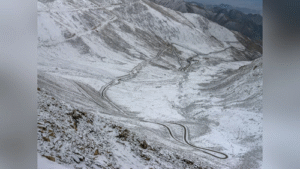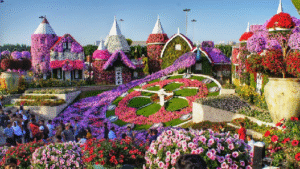Rajasthan, located in the northwestern part of India, is a state that holds the distinction of being the largest state in India by area. It is a land of ancient heritage, unique culture, and spectacular landscapes, ranging from the vast Thar Desert to the historic Aravalli Range. Below is a more detailed exploration of Rajasthan’s geographical features, administrative significance, and cultural and historical importance.
- Area: Rajasthan covers an area of 342,239 square kilometers, making it the largest state in India in terms of land area.
- Percentage of India’s Total Area: Rajasthan accounts for approximately 10.4% of India’s total geographical area (which is about 3.287 million square kilometers).
- Rajasthan is situated in the northwestern region of India.
- It shares an international border with Pakistan to the west.
- It is bordered by the Indian states of Punjab to the north, Haryana and Uttar Pradesh to the northeast, Madhya Pradesh to the southeast, and Gujarat to the southwest.
- A large portion of Rajasthan is covered by the Thar Desert, also known as the Great Indian Desert. It is the world’s 17th largest desert and extends into Pakistan. The desert is characterized by vast stretches of sand dunes, rocky plains, and arid terrain.
- Rajasthan is also home to the Aravalli Range, one of the oldest mountain ranges in the world. The Aravallis run diagonally across the state, offering stunning landscapes and rich biodiversity.
- Rajasthan experiences an arid climate, with scorching summers, mild winters, and very little rainfall, especially in the desert regions.
- The state’s climate contributes to its distinct vegetation, wildlife, and overall environmental character.
- Capital: Jaipur is the capital city of Rajasthan and serves as the administrative and cultural center of the state. It is also popularly known as the “Pink City” due to the distinctive pink-colored buildings in the city, especially in the old town area.
- Rajasthan comprises 33 districts, each with its own distinct cultural, historical, and economic identity. The districts are grouped into divisions for administrative purposes. Some notable districts include Jodhpur, Udaipur, Bikaner, and Ajmer.
- Rajasthan operates under a bicameral legislative system consisting of a Legislative Assembly (Vidhan Sabha) and a Legislary Council (Vidhan Parishad). The state’s Governor acts as the head of state, while the Chief Minister serves as the head of government.
- Forts and Palaces: Rajasthan is known for its magnificent forts, palaces, and havelis that showcase the state’s royal history. Some of the most iconic heritage sites include:
- Amber Fort (Jaipur): A stunning example of Rajput architecture, Amber Fort blends Hindu and Mughal styles.
- Mehrangarh Fort (Jodhpur): One of the largest forts in India, Mehrangarh is perched on a hill and offers a panoramic view of the blue city of Jodhpur.
- Jaisalmer Fort (Jaisalmer): Often referred to as the Golden Fort, this fort is made of yellow sandstone, giving it a golden hue, especially at sunset.
- Chittorgarh Fort (Chittorgarh): A UNESCO World Heritage Site, this fort is a symbol of Rajput valor and sacrifice.
- Located in the Sawai Madhopur district, this national park is famous for its tiger sanctuary. It is one of India’s largest and most renowned national parks, attracting wildlife enthusiasts and photographers from around the world.
- Rajasthan boasts a rich tradition of folk art, including dance forms like Ghoomar, Kalbelia, and Kachchhi Ghodi. The state is also famous for its folk music, which often includes the use of instruments like the dholak, sitar, and sarangi.
- Rajasthan celebrates numerous festivals with great enthusiasm. Some of the most notable ones include:
- Diwali (Festival of Lights)
- Holi (Festival of Colors)
- Teej (Celebrating the union of the goddess Parvati and Lord Shiva)
- Makar Sankranti (Harvest Festival)
- Desert Festival (Held in Jaisalmer, showcasing traditional folk music, dance, and camel rides)
- Agriculture: Rajasthan is a major producer of wheat, barley, mustard, cereals, and millets. Despite the arid climate, irrigation from rivers like the Sutlej, Bhakra, and Indira Gandhi Canal has helped boost agricultural production in certain areas.
- Tourism: Rajasthan is one of the top tourist destinations in India. With its rich cultural heritage, palaces, forts, wildlife sanctuaries, and vibrant traditions, tourism plays a crucial role in the state’s economy. Cities like Jaipur, Udaipur, Jodhpur, and Jaisalmer attract millions of domestic and international visitors annually.
- Mining and Minerals: Rajasthan is rich in mineral resources, including limestone, gypsum, marble, copper, and zinc, making mining an important part of the state’s economy.
Rajasthan’s unique geography, historical significance, and cultural heritage make it a national treasure. With its vast deserts, majestic forts, vibrant festivals, and rich traditions, the state stands out as a symbol of India’s royal past and diverse cultural landscape. The state’s administrative capital, Jaipur, and other cities like Udaipur, Jodhpur, and Bikaner continue to shape the state’s identity, making Rajasthan a key player in India’s socio-economic and cultural fabric.







